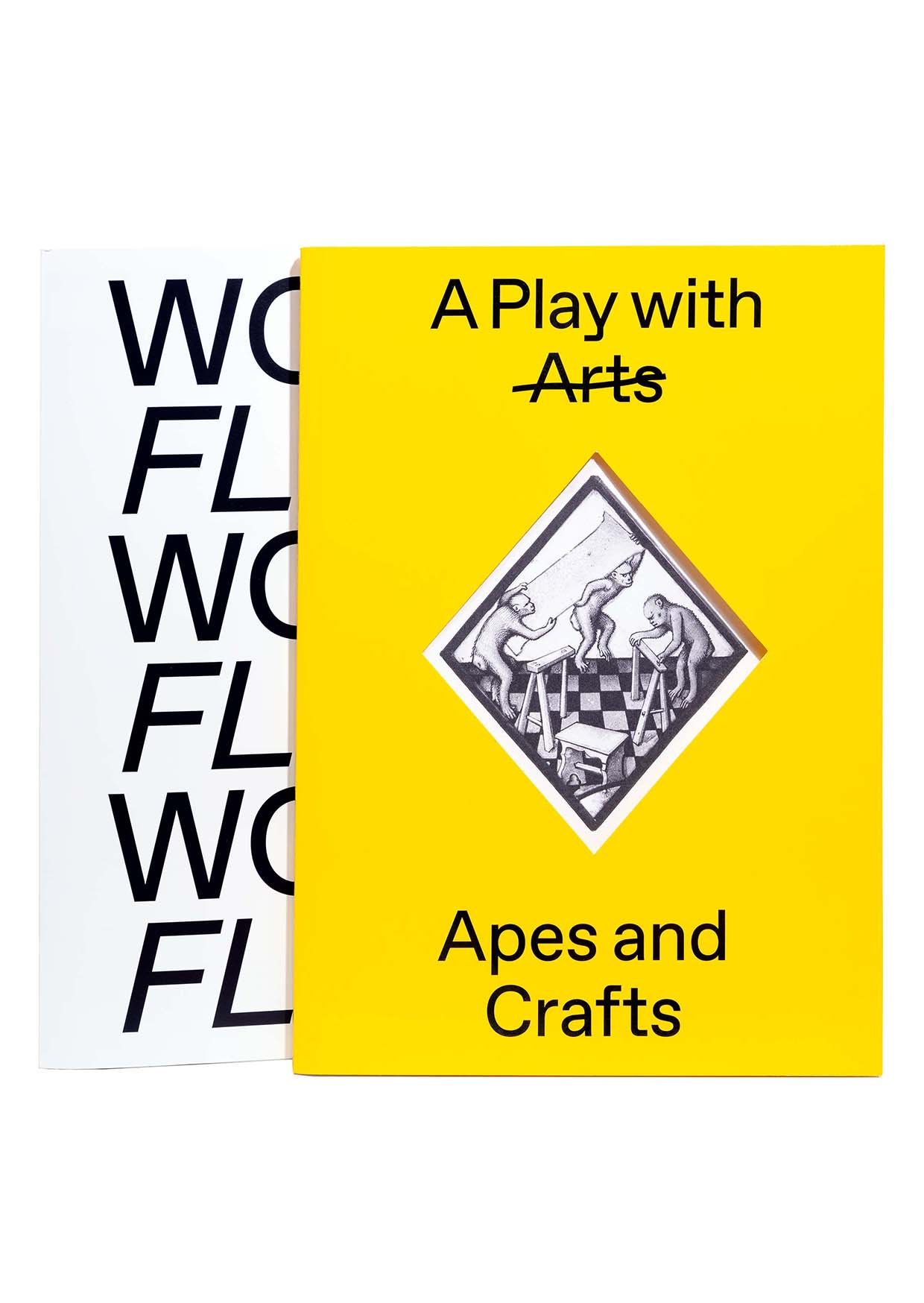WORK FLOW A Play with Apes and Crafts
Original price was: € 15,00.€ 12,00Current price is: € 12,00.
Wim Wauman: WORK FLOW: A Play with Apes and Crafts
Softcover (2 volumes), 24 x 17 cm, 96 p. (reader) + 32 p. (leporello), EN
Publisher: Royal Academy for Fine Arts Antwerp (Track Report 2018/01), April 2018.
Design: Studio Sven Beirnaert.
ISBN: 9789490521370
This publication accompanied the WORK FLOW exhibition at the Cultural Centre of Sint-Niklaas (April 21st – Sept 2nd 2018). A first volume (32p, leporello) visualizes and documents the sequential presentation of nearly 100 contemporary artworks by an international assortment of artists. In the second volume ‘A Play with Arts Apes and Crafts’ (96p, reader) all artworks are reconnected with their makers. Additionally, all works are placed in an idiosyncratic composition of shared knowledge, through the results of a playful exercise in artistic and intellectual craftsmanship.
Displayed artworks by Philip Aguirre, Richard Artschwager, Virginie Bailly, John Baldessari, Evy Bosman, Edward Burtynsky, Paul Casaer, Sarah Corynen, Anton Cotteleer, Joachim Coucke, D.D. Trans, Rik De Boe, Goele De Bruyn, Babs Decruyenaere, Luc Deleu, Wim Delvoye, Peter De Meyer, Stefaan Dheedene, Filip Dujardin, Nick Ervinck, Christophe Floré, Jerry Galle, Alexis Gautier, Paul Gees, Geert Goiris, Ane Hjort Guttu, Quinten Ingelaere, Athar Jaber, Conny Kuilboer, atelier lachaert dhanis, Almudena Lobera, Charlotte Lybeer, Thomas Min, Sofie Muller, Michael Petry, Kelly Schacht, Roeland Tweelinckx, Maarten Vanden Eynde, Antoine Vandewoude, Eric van Hove, Egon Van Herreweghe, Kristof Van Heeschvelde, Herman Van Ingelgem, Ilse Van Roy, Jan Vercruysse, Benjamin Verdonck, Stephen Verstraete, Wim Wauman, Wellness Centre ‘Future Proof’ and Dirk Zoete.
Workflow can mean different things. It mostly refers to the deliberate, rational organization of work, primarily in the context of manufacturing. A workflow usually consists of an orchestrated and repeatable pattern of production activity enabled by the systematic organization of resources into processes that transform materials, provide services, or process information. Although the implementation of schematized workflow principles on the factory floor has proven to be an effective strategy to increase productivity in terms of speed and thus quantity, it also implies a degradation of work for those on both sides of the divide between the work of the hand and work of the mind.
Traditionally, the process of making was characterized by continuity in time and space: local artisans controlled the production chain which took place in the workshop. Artisans relied on skills, acquired through years of practice, and developed a ‘tacit’ intuition which guided their decision-making processes. Simultaneously, the direct involvement with materials through manual work provided practitioners with a sense of satisfaction and pleasure.
In fact, the psychological term flow is highly apt to describe the working activity of artisans.
A flow refers to a mental state of operation in which a person performing an activity is fully immersed in a feeling of energized focus, full involvement, and enjoyment in the process of the activity. The operation required can be both concrete or abstract and the separation of head and hand does not make any difference to being in the zone. Instead of being a highly schematized and pre-patterned activity, a work-flow in this sense denotes an intuitive stream of thoughts and actions, of words and images, walking along a path of discovery.
Along the path of discovery, every certainty is turned into a question. Material is not known for what it is, but by what it does specifically when mixed with other materials, treated in particular ways, or placed in particular situations. As each artwork involves more than one voice, the author of a text is not the sole authority on its meaning. A word, chosen for one reason, brings with it additional layers of meaning. In A Play with Arts Apes and Crafts, Wim Wauman envisions a playful artistic-academic scenario edited and arranged to illuminate the works in the WORK FLOW exhibition. Inspired by a literature study on craftsmanship and guided by his idiosyncratic imagination, the artist interweaves references to popular culture with numerous citations from academic publications, sociological studies, philosophic treatises and internet websites. Through quotes and questions, insights and opinions, Wauman shares his pursuit of knowledge, while blending in his artistic interests and personal concerns. It is a creative exercise in the development of an intellectual craftsmanship. An imaginative tangle of concepts, images and signs. A puzzle*.
The whimsical contours of the WORK FLOW project were shaped by its initiator Wim Wauman, in the context of his ongoing PhD research in visual arts at the Royal Academy of Fine Arts Antwerp. Inspired by a literature study of craftsmanship, the artist explores the notion and potential of ‘craft’ as a way of making, which offers an alternative set of values to those of industrial production, global capitalism and mass consumerism. Craftsmanship is regarded as an attitude characterized by self-reliance, social involvement and a constant striving for quality.
*This project aims to seduce and challenge the spectator, arouse imaginative forces and stimulate autonomous reflection and reasoning. After all, we tend to believe that practice makes perfect and that reason, or what is associated with critical and reflexive thought, can move individuals closer to freedom.


